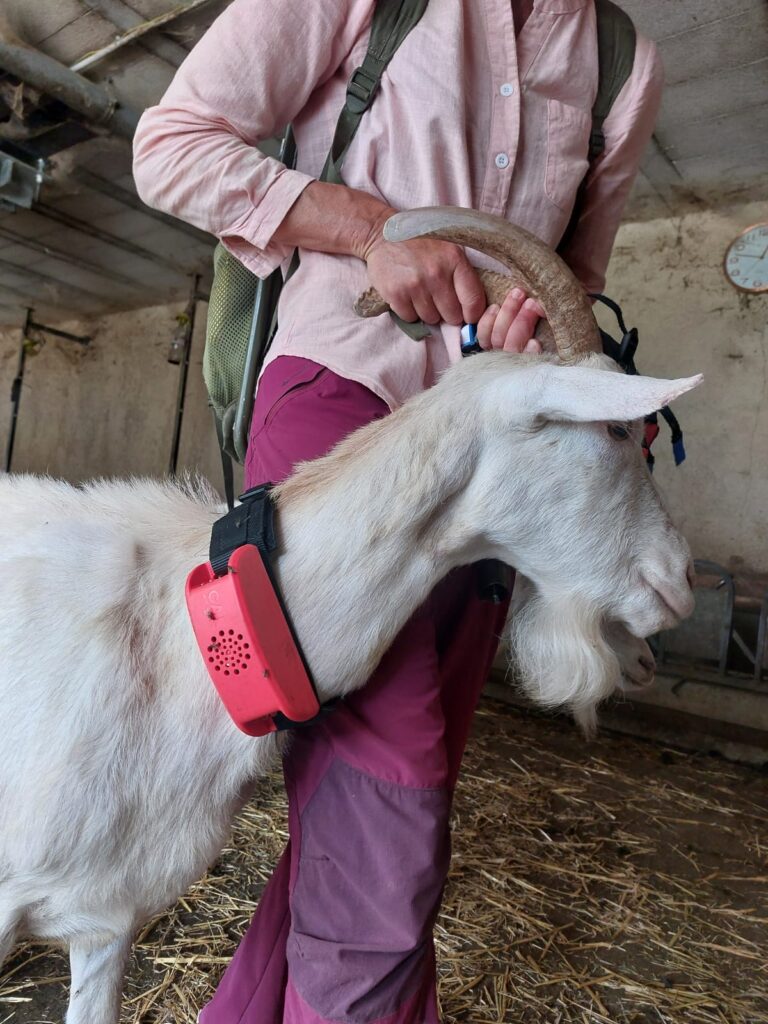Intervention in the Roya valley, France, with the application of anti-wolf collars to goats
Valérie Ratagne has been a dairy goat breeder for 12 years in the commune of Tende, France. Following an attack on her small herd of 35 goats, on June 11 2024, she decided to go all out to ensure the safety of her “girls,” as she calls them. Among the solutions proposed by the Mercantour National Park, it was decided, together with the team of LIFE WolfAlps EU project, consisting of Rachel Berzins and Léa Laudic, to propose the implementation of an experimental prevention device: anti-wolf collars.
Collars work in case of herd panic movements. A fast and abrupt race triggers them, and these then send ultrasounds and light flashes. Wolves, being sensitive to the frequency emitted and of a cautious nature, could be surprised and embarrassed by the device, supposed to cause an avoidant reaction.


Valérie Ratagne with her dairy goats and a anti-wolf collar on one goat. Photo: Sonia, pastoral mediator/ PnM.
This experimental method alone would is not enough to guarantee optimal protection. It is complementary to the almost permanent presence of the breeder during her daily outings with the goats. Valérie is accompanied by her shepherd dogs and does not own livestock guarding dogs. Every night the goats came back to a hard-grilled sheep farm, directly under Valérie’s house, providing a high level of protection.
Thus, the risk of attack is only present during the day. Despite the vigilance of the breeder, some areas where the goats will graze are “dirty”, that is, heavily wooded and sometimes a forest. It’s in one of those places that the wolves attacked, taking advantage of a short absence of Valerie, in broad daylight.
Upon our visit, we provided Valerie with three necklaces. We also placed two photo traps on trails at supposed passing places. The detected presence of wolves, associated with the absence of attack on the herd, would help to corroborate the hypothesis of the effectiveness of collars. It is also always useful to know the composition of a pack (number of individuals, number of adults and young) in order to adapt, on a case-by-case basis, the protection of the herds.


The sheep shelter for the night and a camera trap along the path. Photo: Sonia, pastoral mediator/ PnM.
This protective measure was met with relief and appreciation by Valérie. The emotion of the attack is still greatly felt. The loss of four of her goats, including two little goats and the head goat, as well as milk weakened from the stress of the attack, has been difficult for the breeder to bear.
We have discussed at length and our constructive exchanges fuel our determination to give her our support and help in protecting the flock. As a pastoral mediator, I will be returning regularly during the season to solve the photographic traps and discuss with Valérie other tools we could put in place, such as a scraper.
With wolves, nothing is ever sure. However, we remain optimistic and are hopeful that the implementation of these various measures, together with Valérie’s involvement, will prevent new wolf attacks.









